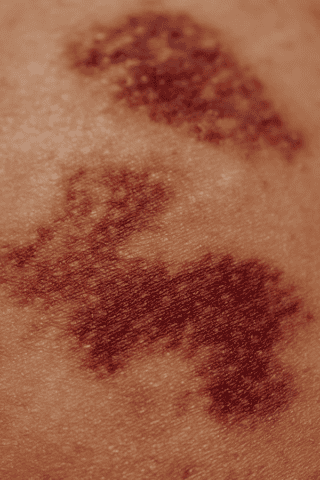Bruises are a common occurrence for people of all skin types, but caring for bruises on Black skin requires some specific considerations. Understanding the nature of bruises and recognizing them on darker skin tones is crucial for proper care and healing. In this article, we will explore the science behind bruising, how skin color affects bruising, immediate care for bruises, long-term care and healing, as well as prevention methods.

Understanding the Nature of Bruises
Bruises, also known as contusions, occur when tiny blood vessels under the skin burst or break. This leads to blood leaking into the surrounding tissue, causing discoloration. Bruises commonly appear as black, blue, or purple marks initially. Over time, they change colors, gradually fading to green, yellow, and eventually disappearing.
The Science Behind Bruising
When an injury or impact occurs, the force causes trauma to the underlying blood vessels. The injured vessels release blood cells, which collect and create the visible bruise. Initially, the blood cells are deoxygenated, giving bruises their characteristic dark color. As the body starts healing, oxygen-rich blood replaces the deoxygenated blood, resulting in color changes.
How Skin Color Affects Bruising
Black skin contains more melanin, the pigment responsible for its darker color. Melanin offers some protection against the sun’s harmful UV rays but can also mask bruise discoloration. Bruises may appear darker on Black skin due to the contrast with the surrounding skin tone. It is vital to be mindful of this when assessing the severity of a bruise.
Interestingly, the location of a bruise on the body can also impact its appearance and healing process. Bruises closer to the heart, where blood circulation is stronger, tend to heal faster than those on extremities like the hands and feet. This is because the blood flow helps carry away the leaked blood more efficiently, aiding in the body’s natural healing mechanisms.
Moreover, certain medications and health conditions can affect how easily someone bruises. Blood-thinning medications, such as aspirin or warfarin, can make a person more prone to bruising as they interfere with the blood’s clotting ability. Additionally, conditions like hemophilia, a disorder that impairs the blood’s ability to clot, can lead to more severe and prolonged bruising. Understanding these factors can help individuals better manage and monitor their bruising tendencies.

Recognizing Bruises on Darker Skin Tones
Identifying bruises on Black skin can be challenging, but there are common signs to look out for:
Common Signs of Bruising
- Discoloration: Bruises appear as dark, bluish, or purplish marks on the skin.
- Tenderness: The bruised area may feel tender or sore to the touch.
- Swelling: In some cases, swelling may accompany bruising.
Differences in Bruise Appearance on Black Skin
On darker skin, bruises may appear as deep shades of blue, purple, or even black. The lack of contrasting skin tones can make the discoloration less noticeable at first. Over time, the bruise may change to brown or yellow before fading away.
It is important to note that the healing process of bruises on darker skin tones can sometimes take longer to fully resolve compared to lighter skin tones. This is due to the increased melanin content in the skin, which can affect the visibility of the bruise as it changes color during the healing stages.
In addition, individuals with darker skin tones may be more prone to developing post-inflammatory hyperpigmentation, where the skin surrounding the bruise darkens as it heals. This phenomenon, known as hemosiderin staining, occurs as a result of the body’s natural response to inflammation and can persist even after the bruise has healed, requiring specific skincare treatments to fade the discoloration.
Immediate Care for Bruises
When a bruise occurs, immediate care can help reduce pain, swelling, and promote healing. Here are some first aid steps:
It’s important to note that a bruise, also known as a contusion, happens when small blood vessels under the skin break and leak blood into the surrounding tissue. This leads to the characteristic discoloration and tenderness associated with bruises. While bruises often heal on their own, taking immediate action can speed up the recovery process and alleviate discomfort.
First Aid Steps for Bruising
- Ice Pack: Apply a cold compress or an ice pack wrapped in a cloth to the bruised area for 15-20 minutes. Repeat this every hour for the first day to reduce swelling.
- Elevation: If the bruise is on an arm or leg, elevate the affected limb to help reduce swelling.
- Pain Relief: Over-the-counter pain relievers, such as ibuprofen or acetaminophen, can help alleviate pain. Follow the instructions on the label.
Additionally, gentle massaging of the area surrounding the bruise can help improve blood circulation and promote the reabsorption of the pooled blood, aiding in faster healing. However, it’s crucial to be gentle to avoid causing further damage to the already sensitive tissues.
Over-the-Counter Products for Bruise Treatment
In addition to the first aid steps, various over-the-counter products can aid in bruise treatment. Topical creams, gels, and ointments containing arnica, aloe vera, or vitamin K may help reduce discoloration and promote healing. These ingredients are known for their anti-inflammatory and skin-soothing properties, which can assist in minimizing the appearance of bruises.
Moreover, maintaining a well-balanced diet rich in vitamin C and vitamin K can support the body’s natural healing process and strengthen blood vessels, reducing the likelihood of bruising. Remember to stay hydrated and consume foods high in antioxidants to aid in tissue repair and regeneration.
Long-term Care and Healing
After the initial first aid, long-term care is essential for optimal healing of bruises on Black skin. It’s important to understand that the healing process may vary depending on the individual’s skin type and overall health. In addition to the following natural remedies and tips, maintaining a healthy lifestyle with a balanced diet and proper hydration can also contribute to faster recovery.
Ensuring that the bruised area is adequately protected from further injury or strain is crucial during the healing process. Avoiding activities that could potentially aggravate the bruise and practicing patience are key components of effective long-term care.
Natural Remedies for Bruise Healing
– Warm Compress: After the first day, applying a warm compress to the bruise can help increase blood flow, promoting recovery. This gentle heat application can aid in reducing pain and swelling, allowing the body to naturally heal the affected area.
– Herbal Supplements: Certain herbs, such as bromelain or calendula, are believed to have anti-inflammatory properties that aid in bruise healing. These natural remedies have been used for centuries in traditional medicine practices and can complement conventional treatments. It is advisable to consult a healthcare professional before trying any herbal remedies to ensure compatibility with individual health conditions.
– Gentle Massage: Light massaging around the bruised area, using gentle circular motions, can help stimulate blood flow and speed up healing. This technique should be performed with caution to prevent further damage to the skin and underlying tissues. Avoiding vigorous rubbing or applying too much pressure is essential to prevent exacerbating the bruise.
When to Seek Medical Attention
While most bruises heal on their own, certain situations warrant medical attention. It is essential to monitor the progress of the bruise and seek professional advice if any concerns arise. This is especially true if you are on any medications that thin the blood such as warfarin or aspririn. Consulting a healthcare professional is recommended if:
- The bruise is accompanied by severe pain that doesn’t subside.
- The bruise does not improve within two weeks.
- There is rapid or excessive swelling around the bruised area.
- You have concerns about the appearance or healing process of the bruise. Laser treatment can help bruises resolve faster.
Prevention of Bruises
Prevention is always better than cure when it comes to bruises. Here are some lifestyle changes and protective measures that can reduce the risk of bruising:
Bruises, also known as contusions, occur when small blood vessels under the skin break and leak blood, causing discoloration and tenderness. While bruises are usually harmless and heal on their own, they can be unsightly and sometimes painful. By incorporating certain habits into your daily routine, you can minimize the chances of developing bruises.
Lifestyle Changes for Bruise Prevention
- Exercise regularly to improve balance and strengthen muscles, reducing the risk of falls and injuries.
- Ensure proper lighting in your home and workplace to prevent accidental bumps and falls.
- Maintain a healthy diet rich in vitamin C and K to support collagen production and strengthen blood vessels.
In addition to physical measures, emotional well-being can also play a role in bruise prevention. Stress and anxiety can lead to clumsiness and distraction, increasing the likelihood of accidents that result in bruises. Practicing mindfulness and relaxation techniques can help you stay focused and coordinated, reducing the risk of injury.
Protective Measures for High-risk Activities
If you engage in high-risk activities, such as contact sports or manual labor, consider taking these precautions:
- Wear appropriate protective gear, such as helmets, pads, or gloves.
- Use padding or cushions in areas prone to injuries.
- Take breaks and rest as needed to prevent fatigue-related accidents.
Furthermore, staying hydrated is crucial for maintaining skin elasticity and overall health. Dehydrated skin is more prone to damage and bruising, so make sure to drink an adequate amount of water throughout the day. Hydration not only benefits your skin but also supports the body’s natural healing processes, aiding in the quicker recovery of any existing bruises.
Conclusion
In conclusion, caring for bruises on Black skin requires understanding the nature of bruises, recognizing signs of bruising on darker skin tones, immediate care, and long-term healing methods. By following the recommended first aid steps, utilizing natural remedies, and taking preventative measures, you can effectively care for bruises and promote healing. Remember to seek medical attention if needed and make necessary lifestyle changes to reduce the risk of future bruises.


